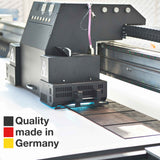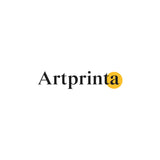Auguste Renoir, 1885 - Still Life with Flowers and Prickly Pears - fine art print
Taxes incluses. Frais de port calculés au paiement.
Summarization of the replica
Still Life with Flowers and Prickly Pears is a piece of art made by the French painter Auguste Renoir in 1885. The original version was painted with the exact size: 28 7/8 x 23 3/8 in (73,3 x 59,4 cm) and was manufactured with oil on canvas. Nowadays, this artwork forms part of the The Metropolitan Museum of Art's digital art collection. With courtesy of - The Metropolitan Museum of Art, New York, Bequest of Catherine Vance Gaisman, 2010 (public domain). In addition, the work of art has the creditline: Bequest of Catherine Vance Gaisman, 2010. Besides, the alignment is in portrait format and has a side ratio of 1 : 1.2, which implies that the length is 20% shorter than the width.
Choose a art print material option
We offer a range of different sizes and materials for every product. We allow yout to choose among the following variants:
- Canvas print: The printed canvas, which shall not be confused with a canvas painting, is a digital replica printed on an industrial printing machine. A canvas produces a unique look of three dimensionality. A canvas print of your favorite work of art will give you the chance of turning your fine art print into a large artwork as you know from galleries. Canvas prints are relatively low in weight, which implies that it is easy to hang your Canvas print without any wall-mounts. Because of thatcanvas prints are suited for all kinds of walls.
- The poster print (canvas material): A poster print is a UV printed canvas with a granular finish on the surface. It is excellently suited for putting the art copy with the help of a custom-made frame. Please keep in mind, that depending on the size of the canvas poster print we add a white margin of approximately 2-6cm around the work of art in order to facilitate the framing.
- Aluminium dibond print: This is a metal print made on aluminium dibond material with an impressive depth. For the Aluminium Dibond option, we print the selected artwork onto the aluminium composite white-primed surface. The UV print on Aluminum Dibond is one of the most demanded entry-level products and is an extremely stylish way to display artworks, as it draws attention on the image.
- Glossy acrylic glass print (with real glass coating): An print on acrylic glass, which is often referenced as a print on plexiglass, will change the original into home decoration. Further, it offers a viable alternative to aluminium and canvas fine art prints. Your own replica of the work of art will be custom-made thanks to the help of modern UV direct print machines. This makes deep, rich colors. The major advantage of a plexiglass print is that contrasts plus small details will be identifiable due to the granular tonal gradation in the picture. Our acrylic glass protects your custom art print against sunlight and heat for many years to come.
Legal note: We try to depict our art products with as many details as possible and to showcase them visually. Nevertheless, the pigments of the printing material and the print result can differ slightly from the presentation on the device's monitor. Depending on the settings of your screen and the condition of the surface, colors can unfortunately not be printed as exactly as the digital version depicted here. Given that the art prints are processed and printed by hand, there may as well be minor deviations in the motif's exact position and the size.
Structured product details
| Print prodct: | fine art reproduction |
| Reproduction: | digital reproduction |
| Manufacturing process: | UV direct printing |
| Product Origin: | German-made |
| Type of stock: | on demand production |
| Intended product use: | wall gallery, gallery wall |
| Orientation of the image: | portrait format |
| Aspect ratio: | 1 : 1.2 - (length : width) |
| Image aspect ratio implication: | the length is 20% shorter than the width |
| Available material variants: | metal print (aluminium dibond), poster print (canvas paper), acrylic glass print (with real glass coating), canvas print |
| Canvas print (canvas on stretcher frame) variants: | 50x60cm - 20x24", 100x120cm - 39x47", 150x180cm - 59x71" |
| Acrylic glass print (with real glass coating) size options: | 50x60cm - 20x24", 100x120cm - 39x47" |
| Poster print (canvas paper): | 50x60cm - 20x24", 100x120cm - 39x47" |
| Aluminium dibond print (aluminium material) sizes: | 50x60cm - 20x24", 100x120cm - 39x47" |
| Art print framing: | not included |
Piece of art specs
| Work of art title: | "Still Life with Flowers and Prickly Pears" |
| Artwork classification: | painting |
| General category: | modern art |
| Period: | 19th century |
| Year of creation: | 1885 |
| Approximate age of artwork: | more than 130 years |
| Artwork original medium: | oil on canvas |
| Artwork original dimensions: | 28 7/8 x 23 3/8 in (73,3 x 59,4 cm) |
| Museum / location: | The Metropolitan Museum of Art |
| Museum location: | New York City, New York, United States of America |
| Available under: | The Metropolitan Museum of Art |
| License type of artwork: | public domain |
| Courtesy of: | The Metropolitan Museum of Art, New York, Bequest of Catherine Vance Gaisman, 2010 |
| Creditline: | Bequest of Catherine Vance Gaisman, 2010 |
General information on the artist
| Artist name: | Auguste Renoir |
| Artist gender: | male |
| Artist nationality: | French |
| Professions: | painter |
| Home country: | France |
| Artist category: | modern artist |
| Life span: | 78 years |
| Birth year: | 1841 |
| Died in the year: | 1919 |
© Copyright of | Artprinta (www.artprinta.com)
Additional description by The Metropolitan Museum of Art (© - The Metropolitan Museum of Art - The Metropolitan Museum of Art)
This picture is closely related to Still Life: Flowers, 1885 (Solomon R. Guggenheim Museum, New York), which depicts the same vase—with its distinctive elephant-head handles—and wood table or dresser. Featuring an autumnal bouquet and Cézannesque arrangement of prickly pears, the present still life was likely painted the same year, in the wake of a visit with Cézanne that summer. At this time, Renoir sought to combine the luminosity of Impressionism with a greater degree of classicism, prompting him to explore techniques that would emulate the dry, light colors of Italian frescoes, which have led to some surface cracks.














